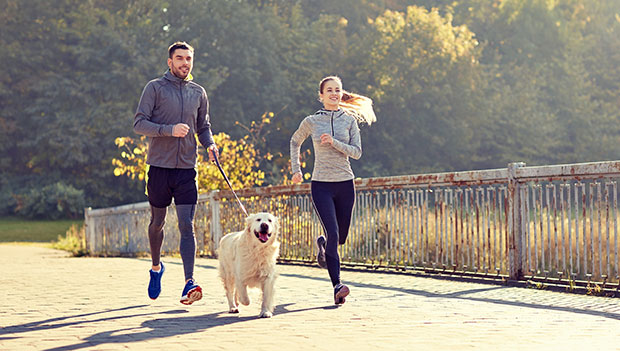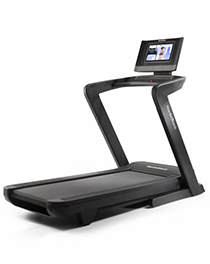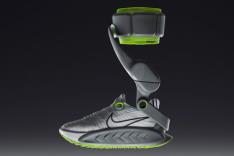
By clicking on the product links in this article, we may receive a commission fee at no cost to you, the reader. Sponsorships and affiliate commissions help support our research so we can help you find the best products. Read our full affiliate disclosure here.
When we got our large-breed, energetic puppy, I knew that as soon as our vet OK'ed it she and I would start pounding the pavement together. Other than an occasional lingering sniff, our runs went well. Until they didn't. Until the geese.
The day we came upon a gaggle of squawking geese, the goodest girl in the world went a little feral, and I, well, I went through someone's hedges. As I cleaned and bandaged my scrapes, I realized that I had a lot more to learn about running with my dog.
To help you avoid the same mistakes, I sat down with Katrina Kensington, the owner and head trainer of KeenDog, a dog training service that offers a variety of training programs.
If your pup isn't into running with you, you can train inside with a new Nordictrack Treadmill:
Basic Training Tips
Before you start running with your dog, make sure they are healthy and ready for the exercise. Dogs that are too old or too young might not be able to handle a running program. In fact, Kensington advises that dogs who are younger than 18 months should stick to walking. Puppies' bones are still developing clear up to 18 months old and running can impact their bone development and optimal long-term physical integrity. Walking with a younger dog will help build a strong base for a future running program.
When your dog is mature and strong enough to run, Kensington recommends that you use a loose leash rather than a harness. Harnesses should only be implemented if you need the dog's assistance with pulling you (and this is not something that most people would need). The loose leash method will allow the dog to pace beside you rather than pull you. This also allows you to train your dog to yield to collar pressure.
How Far To Run
Although dogs may seem like they have endless energy, they, like humans, still have to be conditioned for running. Kensington advises allowing your dog to build up the mileage. Once your dog's conditioning has improved, you should still cap the runs at 5 to 6 miles and no more than 3 days per week.
It may be frustrating at first because your dog isn't going at the same pace as you, which is why “it is important to have a little fluidity in your pace,” per Kensington.
By making minor adjustments to your pacing and not allowing your dog to run in a zigzag pattern, you will be off to a great start. With consistency, your dog will adapt to your pace and start yielding to collar pressure so that you both have years of happy running together.
Temperature and Terrain
It is important to always pay close attention to the temperature outside. Heat can be incredibly taxing to dogs, especially those with thicker coats or shorter snouts. Kensington stresses that in the heat of the summer it is always best to stick to early morning or evening runs with your dogs. You would also not want to stay out for long at one time when it is very cold.
In the fall and spring, you have a little more flexibility with the timing of your runs, but you will always want to be cognizant of the terrain that your dog is running on. Kensington states that you don't want to literally pound the pavement when you are running with your dog. Concrete and asphalt are especially hard on dogs' joints and both surfaces can also damage their paws.
Reward Systems
Positive reinforcement is Kensington's go-to training reinforcement. She says that food is many people's go-to when it comes to rewards, but that while a treat is rewarding for the dog, as soon as they gulp it down the reward is gone. Play is her number one reward because it continues the positive reinforcement through the play. It becomes a fun game and it helps to form a deeper bond. Additionally, the act of running is a treat for dogs. They want to do it and it is rewarding for them.
Warning Signs
Even well-conditioned dogs can develop issues when running. Kensington notes the importance of watching for warning signs such as panting, shaking, and sweaty paw pads. If you notice any of these symptoms, immediately slow to a walk and let them cool off. You can give them a little water, but make sure that you limit the amount that they take in. If your dog chugs water mid-run, they could develop gastric dilatation-volvulus, which is commonly referred to as bloat. Bloat occurs when a dog's stomach fills with water, food, or gas and then twists. This is always an emergency situation.
Dog Treadmills
On the days that it's raining cats and dogs (pun intended) but you want to keep your dog's training up and energy down, you can always turn to a dog treadmill. Kensington is a proponent of treadmill training and she has used it with all of her personal dogs.
Dog treadmills are great for inclement weather, but they also come in handy if you have multiple dogs and it is not safe to run them together or if you had a long day at work and don't have time to get your run in. The treadmills used by KeenDog let you set the pace and the dog runs at that set speed. There are also treadmills that the dog powers by running, which allows them to speed up or slow down at their own pace. These may be preferable for home use as they hold the dog, and not the person, accountable for the speed.
Although it will take a little patience, with a commitment to proper training, your dog and you will make great running partners in no time. And who knows—once you conquer running with your dog it may be time to take them to the water and try kayaking or paddle boarding. If that’s not something that you want to handle on your own, there are knowledgeable and loving professionals like those at KeenDog to help you along.
How to Train Your Dog to Run With You | Best Hiking Gear for Dogs | Best Dog Harnesses | Best Dog Foods | Best Dog Leashes | Best Dog Balls | Best Dog Frisbees | Best Dog Backpacks | Best Dog Toys | Best Dog Beds | Best Dog Treadmills
Get ACTIVE on the Go


Couch to 5K®
The best way to get new runners off the couch and across the finish line of their first 5K.
Available for iOS | Android








Discuss This Article